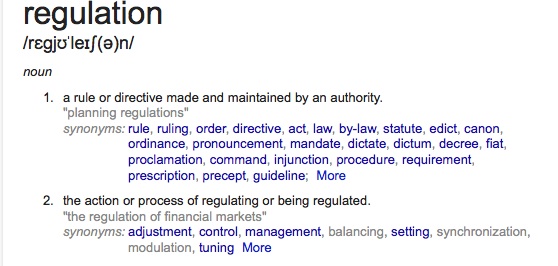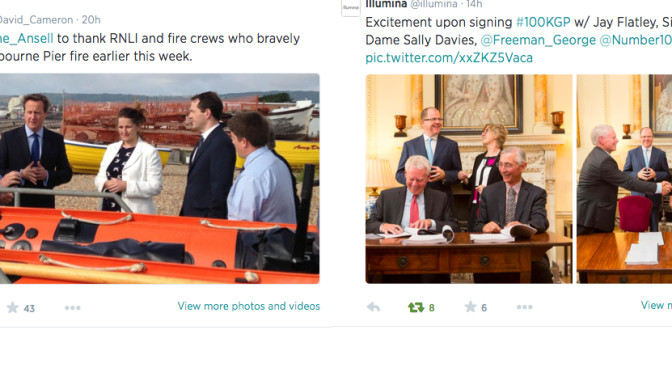Regulation, the use of regulatory powers and the authority to oversee them, are in flux in England.
Some will have lesser discussed, but long term, wide ranging effects such as the regulatory framework and requirement for profit in almost all public bodies.
A significant amendment [1] appears to have been proposed by Lord Hunt of Kings Heath on 9th Jan, 2015 in the Deregulation Bill [2]. The next discussion date of which seems to be provisionally scheduled for February 3rd and 5th.
The amendment proposes the removal of ten regulatory functions in health and care, from the requirement to exercise the clause of considerable concern, renamed from clause 83 to clause 88: the statutory duty towards a desirability to promote economic growth.
My last post in November on this clause was after the debate in which Lord Tunnicliffe concluded:
”if our fears comes to pass, these three clauses could wreak havoc in a regulatory regime within this country.”
Later he asked:
“are these new clauses a licence for regulators to approve regulations that kill people to save money?”
Clause 88: background on the clause to ‘promote economic growth.’
Almost a year ago, in February 2014, [3] MPs had discussed this same clause in its passage in the House of Commons.
MPs were asked to support a reasoned amendment tabled by Caroline Lucas, Jonathan Edwards, John McDonnell and Jeremy Corbyn MPs.
They proposed the removal of the clause, requiring the desirability for economic growth, and they had concerns:
…”that this Bill represents a race to the bottom and an obsession with GDP growth at any cost which is not in the public interest.”
(my underlining):
[…]”the Health and Safety Executive, which is irresponsible and risks undermining their core roles; further considers that this Bill is another illustration of a Government which is embarking on a deregulatory path without due consideration of warnings, including from businesses, that effective regulation is essential to create jobs and innovation and that ripping up vital green legislation risks locking the UK into polluting industrial processes for decades to come, jeopardising future competitiveness, damaging the UK’s attractiveness for green investment, and undermining new industries.”
This clause must be reviewed thoroughly and transparently from scratch. If indeed these ten bodies are to be considered for exclusion from the clause there must be a detailed case of why. This leads automatically to ask for the benefits to justify the inclusion of others. If this has not been made transparent to the Lords debating the clause by now, then the bill should not pass as is without reasonable justification.
Is there an MP or Lord who will gladly take the responsibility to say:
“I agreed to a new law, the consequences of which I was not clear, but I did not ask the questions I should have done. I ignored that Lord Tunnicliffe asked: “are these new clauses a licence for regulators to approve regulations that kill people to save money?” And I did not examine why this might be for each and every function of regulation it affects.”
Based on what decision criteria and based on what measures or public interest test has this department area been selected for exclusion and others, such as the environment, been omitted?
Considering the reported opinion of the Bill’s proponent Oliver Letwin MP to the NHS it sould seem wise to ask, what kind of National Health Service do our MPs expect to see in future under this new model of statutory requirement to seek profit.
In conclusion:
Is the bill designed to future-proof regulatory common sense or set it up for widespread failure from the start?
In the words of Lord Tunnicliffe:
“The problem is the clauses themselves. Clause 83(2) states that:
‘the person must … consider the importance for the promotion of economic growth of exercising the regulatory function in a way which ensures that … regulatory action is taken only when it is needed, and … any action is proportionate”.
“Those words by themselves seem a pretty high test for a regulator. As I tried to illustrate, our lives are made acceptable and benign by regulators acting pretty well as they do at the moment to protect us. So are these new clauses a licence for regulators to approve regulations that kill people to save money?”
It should be made very transparent what bodies will be affected, why, how the decision making in each function will be carried out and what with? At national or local level ruling authority?
Clearly there is still work to be done to ensure that the implications in the public interest. That ethic seems to have been lost at the back of the vast cupboard of all that the deregulation bill has in store.
Alongside the changes to the sale of liqueur chocolates and weights and measures for knitting yarn we have lost something much greater in the Deregulation Bill.
However this amendment suggests there is new hope coming for the proposed change to regulatory powers and their profit making; that in fact, some significant bodies may be made exempt of this duty on a statutory footing.
Now the case should be made why any public bodies should not be.
Simply, the wider Public Interest must come first, above profit.
Perhaps when one hears calls to ignore criticism of these proposals of deregulation in this bill and in TTIP one would do well to ask why.
Anything else could be as disastrous for society, as the Poll Tax is now accepted to have been for Margaret Thatcher.
But perhaps, some would maintain, there is still no such thing?
*********
For those with more in depth interest:
Further detail; below I continue and review the amendment, wider implications at local authority level, changes in the future landscape of health and social care and why it could be of significant negative impact on political and social trust.
This is my update on two previous posts; Part one: October 4th, Deregulation Bill Clause 47 and the back door access to journalist sources and Part two: the Deregulation Bill Clause 83 from 6th Nov with additional notes on Nov 21st.
It continues with Part four to follow: The Deregulation Bill: Part IV New Hope for Regulatory powers?
*****
The amendment
Here is what it looks like:
(a) Care Quality Commission,
(b) Human Tissue Authority,
(c) Medicines and Healthcare Products Regulatory Agency,
(d) Professional Standards Authority,
(e) General Medical Council,
(f) Nursing and Midwifery Council,
(g) Health and Care Professions Council,
(h) General Chiropractic Council,
(i) General Dental Council,
(j) General Pharmaceutical Council,
(k) Human Fertilisation and Embryology Authority, and
(l) any persons exercising a regulatory function with respect to health and care service that the Secretary of State specifies by order.
( ) An order under this section must be made by statutory instrument.
( ) A statutory instrument containing an order under this section may not be made unless a draft has been laid before, and approved by a resolution of, each House of Parliament.”
What would the amendment change, if they become law?
These exceptions are specific to healthcare and, it remains to be seen if they will be adopted.
There is also some provision, to make further special cases for the health and care service more broadly, that the Secretary of State specifies by order.
This addresses some organisations in the regulation of health and care.
But it opens up the question more clearly why should other bodies be included? Where is the benefit – and where is the cost and risk analysis?
That would be a most welcome discussion in the public interest. Some professionals and professional bodies have already flagged their concern.
The Equality and Human Rights Commission is one example, that was discussed in the last debate andthe ECHR response to it. [4]
Nov 21st update: see Column GC229 < and whilst verbal assurances were made, it appears nothing changed in the Bill, and that the EHRC said in response:
“While we welcome this undertaking we understand that this doesn’t mean that we’ll be removed on the face of the Bill”.
The ECHR clearly sees it as detrimental and asks for change. Will the government ride roughshod over professional opinion without transparent and thorough justifications of the need for this?
If so, it seems an extraordinary dismissal of democracy.
Other bodies should take the lead from the EHRC and make their positions clear in the public domain now, or risk future backlash once the impacts become clear.
What wider impact will this amendment have?
At first the effect appears to be that a significant number of health related bodies could be freed from the duty to make a profit.
At national level this seems a welcome and sensible step.
However it’s not the whole story.
How these bodies perform their tasks at national level and how far down their powers reach will affect the organisations below them.
These lower branches of organisational structure also need to be understood for any regulatory implications. How that function is carried out under what powers needs to be clear at what point the removal of the requirement would have an effect.
“You’re not going to have, in the future, a separate police station, ambulance station, schools, health service buildings and so on”, he said. [Jan 4th 2015, FT]
Questions were raised in November as to the extent of the reach of the CQC surveillance powers at practice level, reviewing individual patient medical records ‘to assess the quality of care provided by the practice’ without individual consent. Professionals on social media raised their electronic eyebrows and lamented the breach of confidentiality.
What deeper impact will this have?
What happens should the CQC powers be broken up at national level and carried out at local level instead needs to be examined.
The body having been made exempt at national level from this commercially driven clause, may find that the regulatory functions would be required to comply with it again at Local Authority level.
The reasons why the CQC should be made exempt, would therefore be lost in the transition, unless the special orders and special provision were made before any organisational restructure.
The timing therefore of new regulations would need to become integral to any departmental organisational change at any and every level of regulatory governance.
Instead of removing ‘red tape’ and bureaucracy in this bill, I foresee it adding a burden of analysis and requirement to assess and document responsibilities; determining whether or not the clause to promote economic growth should apply or not.
Its definition is so vague and its responsibility to be ‘proportionate’ so open, that in fact it is not assigned to anybody; which everybody knows, means it ends up being done, by nobody.
Every time some any reorganisation is planned, the impact of this regulatory clause may need considered and not only in health and social care but in every aspect of regulatory function across government.
Every action a regulatory body takes, is by default ‘regulatory action.’ So any time the function should do its job, each and every time, every decision, every ruling, would need to consider the need for economic growth and if they need to act at all.
(a) regulatory action is taken only when it is needed,
and
(b) any action taken is proportionate.
Surely this is what they do already in every decision, and therefore why make it a statutory requirement at all – for any regulatory body?
If we don’t need it, why write it in. And if we do need it, what precisely is it intended to do, how and why?
I would encourage anyone who has not yet done so, to have a good look over the contents of the bill. It’s like an end of year sale and there is definitely something in there for everyone. The likelihood is high that some unforeseen damage will be done to the public interest in the rush to get it through in this term by government, akin to a Black Friday panic. The bills lined up to rush through the last minute doors of parliament, seem to be queueing in droves.
For bodies which have regulatory functions today in health and social care at Local Authority level already, the hoped for reduction in harm through this amendment affecting their national level body, could fail to materialise.
(a) regulatory action is taken only when it is needed,
and
(b) any action taken is proportionate.
“Guido has no intention of registering with the Electoral Commission or reporting a penny of spending or anything else to them. This authoritarian law is a nonsense. If you read the guidance it should apply to newspapers. We haven’t just rejected statutory control of the printed press by one regulator for political control of digital media by another.”
Here we arrive at the nub of the issue: what is to be deregulated and why and by whom are fundamental to understand what effects these changes will require, and the demands the duty for economic growth will create.
I question: “Can this dramatic change, really be a wise and throroughly thought out course of action, when the only certainty in the affected organisations’ governance duties is that in fewer than five months, it may all change?”
“These roles and responsibilities outline much of the work we do in order to meet our objectives of:
- well-run elections, referendums and electoral registration
- transparency in party and election finance, with high levels of compliance”
How will the Electoral Commission maintain neutrality if profit must drive the function as the regulator of political funding and spending?
That decision could have almighty and lasting effect on public confidence and our trust in the wake of the MP expenses scandals.
Without a publicly available clear cost benefit analysis, the overwhelming drive for profit in every sector of UK regulatory reach remains at best unclear. The intended benefits or whether they will even create any efficiencies, never mind public gain, lacking.
At worst, “are these new clauses a licence for regulators to approve regulations that kill people to save money?”
****
Key references:
[1] Proposed amendment by Lord Hunt of Kings Heath in the Deregulation bill.
[3] Hansard, February 3 2014, MPs propose removal of clause
[4] Hansard, November 20th 2014, ECHR comments included in Lords’ debate
[5] Public Health functions under Local Authority
[6] Local Authority regulatory functions
********
List of The National Regulators – the ten bodies above are those explicitly mentioned in Lord Hunt of King’s Heath’s amendment:
Animal Health and Veterinary Laboratories Agency (AHVLA)
Animals in Science Regulation Unit
Architects Registration Board (ARB)
British Hallmarking Council (BHC)
Charity Commission for England and Wales
Civil Aviation Authority (CAA)
Claims Management Regulation Unit
Professional Standards for Health and Social Care (PSA)
Disclosure and Barring Service (DBS)
Drinking Water Inspectorate (DWI)
Driver and Vehicle Licensing Agency (DVLA)
Driving Standards Agency (DSA)
Employment Agency Standards Inspectorate (EAS)
Equality and Human Rights Commission
Financial Reporting Council (FRC)
Fish Health Inspectorate (FHI), Centre for Environment, Fisheries and Aquaculture Science (Cefas)
Food and environment research agency (plant and bee health) and (Plant Variety and Seeds)
Gangmasters Licensing Authority (GLA)
General Medical Council
General Chiropractic Council
General Pharmaceutical Council
Health and Safety Executive (HSE)
Higher Education Funding Council for England (HEFCE)
HM Revenue and Customs (Money Laundering Regulations and National Minimum Wage)
Homes & Communities Agency (HCA)
Human Fertilisation and Embryology Association (HFEA)
Information Commissioner’s Office (ICO)
Insolvency Service including Insolvency Practitioner Unit
Intellectual Property Office (IPO)
Marine Management Organisaton (MMO)
Maritime and Coastguard Agency (MCA)
Medicines and Healthcare Products Regulatory Agency (MHRA)
National Measurement Office (NMO)
Nursing and Midwifery Council
Office for Nuclear Regulation (ONR)
Office for Standards in Education, Children’s Services and Skills (OFSTED)
Office of Rail Regulation (ORR)
Office of the Regulator of Community Interest Companies
Security Industry Authority (SIA)
Sports Grounds Safety Authority (SGSA)
Trinity House Lighthouse Service (THLS)
Vehicle and Operator Services Agency (VOSA)
Vehicle Certification Agency (VCA)
Veterinary Medicines Directorate (VMD)
***
Please feel free to comment below or find me on twitter @TheABB




![Launching genomics, lifeboats, & care.data [part 2]](https://jenpersson.com/wp-content/uploads/2014/08/rosetta_image-672x372.jpg)


